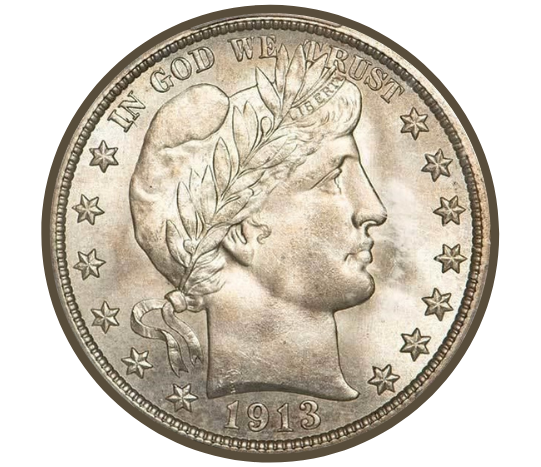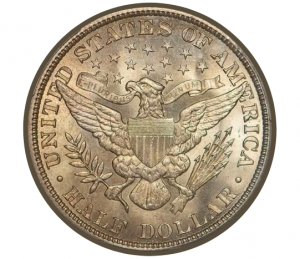
The 1913 Barber Half Dollar is the Professional Grading Service’s (PCGS) Coin of the Month (PCGS MS66+).
When one thinks about early 20th-century rarities, the mind often turns to branch-mint outputs by the likes of the New Orleans Mint or San Francisco Mint. But the Philadelphia Mint also produced its fair share of scarce coins, including a slew of Barber half dollars from 1913 through 1915. All three of the Philadelphia issues from the period ranked mintages of fewer than 200,000, which is an extremely small number for the half dollar, which was a workhorse coin in the context of the early 20th century United States.
The year 1913 saw an emission of just 188,000 half dollars from the Philadelphia Mint, which to that point was the smallest business-strike output for the series, and it became the third smallest when all was said and done, thanks to the even smaller mintages in 1914 and 1915, when only 124,230 and 138,000 were minted, respectively. The 1913 Barber half dollar has long enjoyed robust demand from collectors and is a difficult coin even in Good-4, where pieces can clip at $70 apiece or even higher.
Barber halves are a conditional scarcity across the board in Fine-12 or better, and the 1913 issue proves no exception there – prices for that piece take $200 and up at that grade threshold. Above MS66, prices enter well into the five-figure territory, as evidenced by a gorgeous MS66+ specimen graded by Professional Coin Grading Service that fetched $19,388.

Coin Grading
Grade refers to a coin’s level of preservation: how many nicks or scratches or other imperfections it has. Coins are graded on a scale of one to 70, with higher numbers signifying higher grades. One represents a coin that is so well worn that it’s barely identifiable as to its type. 70 represents a perfect coin: a coin that when viewed under a five-power magnifying glass has no visible imperfections.
60 through 70 represent the Mint State (MS) grades. A coin graded MS-60 can have so many nicks and scratches and flaws that it might look as if Godzilla used it as a teething ring. MS-65 is the industry standard for “Gem.” MS-66 through MS-69 are the near-flawless super-grade or wonder coin assignations. With each grade level above MS-66, the value might double or triple.
Grade names are used in addition to numerical grades. In ascending order, these word grades are About or Almost Good; Good; Very Good; Fine; Very Fine; Extra or Extremely Fine; About or Almost Uncirculated; and Mint State.
A Proof is not a special Mint State coin. Proof refers to a method of manufacture, not a grade. Although Proof coins are struck using specially polished dies and specially selected planchets (metal discs) to assure a chromium-like brilliance, they can circulate or be spent. Proofs are also graded on the one through 70 scale. A Proof coin grading less than Proof-60 is referred to as an “impaired Proof.”
The Professional Coin Grading Service (PCGS) and the Numismatic Guaranty Company (NGC) are the coin field’s highest-volume authentication and grading services. PCGS and NGC encapsulate coins in sonically-sealed hard plastic holders that are tamper-evident. Most buyers of valuable coins demand only coins that have been certified by leading grading services. These services offer guarantees of authenticity and grade, and their coins often trade sight unseen based on their certified grade.
*Images courtesy of Legend Rare Coin Auctions.
















